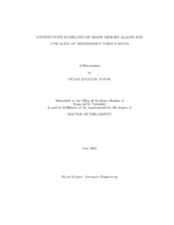| dc.contributor.advisor | Lagoudas, Dimitris C. | |
| dc.creator | Popov, Petar Angelov | |
| dc.date.accessioned | 2005-08-29T14:37:23Z | |
| dc.date.available | 2005-08-29T14:37:23Z | |
| dc.date.created | 2003-05 | |
| dc.date.issued | 2005-08-29 | |
| dc.identifier.uri | https://hdl.handle.net/1969.1/2273 | |
| dc.description.abstract | Shape Memory Alloys (SMAs) are metal alloys which are capable of changing
their crystallographic structure as a result of externally applied mechanical or thermal
loading. This work is a systematic effort to develop a robust, thermodynamics based,
3-D constitutive model for SMAs with special features, dictated by new experimental
observations. The new rate independent model accounts in a unified manner for the
stress/thermally induced austenite to oriented martensite phase transformation, the
thermally induced austenite to self-accommodated martensite phase transformation
as well as the reorientation of self-accommodated martensite under applied stress. The
model is implemented numerically in 3-D with the help of return-mapping algorithms.
Numerical examples, demonstrating the capabilities of the model are also presented.
Further, the stationary Fluid-Structure Interaction (FSI) problem is formulated
in terms of incompressible Newtonian fluid and a deformable solid. A numerical
method is presented for its solution and a numerical implementation is developed.
It is used to verify an existing asymptotic solution to the FSI problem in a simple
channel geometry. The SMA model is also used in conjunction with the fluid-structure
solver to simulate the behavior of SMA based filtering and flow regulating devices.
The work also includes a numerical study of wave propagation in SMA rods.
An SMA body subjected to external dynamic loading will experience large inelastic
deformations that will propagate through the body as phase transformation and/or
detwinning shock waves. The wave propagation problem in a cylindrical SMA is
studied numerically by an adaptive Finite Element Method. The energy dissipation
capabilities of SMA rods are estimated based on the numerical simulations. Comparisons
with experimental data are also performed. | en |
| dc.format.extent | 2779261 bytes | en |
| dc.format.medium | electronic | en |
| dc.format.mimetype | application/pdf | |
| dc.language.iso | en_US | |
| dc.publisher | Texas A&M University | |
| dc.subject | Shape Memory Alloy | en |
| dc.subject | Fluid Structure Interaction | en |
| dc.title | Constitutive modelling of shape memory alloys and upscaling of deformable porous media | en |
| dc.type | Book | en |
| dc.type | Thesis | en |
| thesis.degree.department | Aerospace Engineering | en |
| thesis.degree.discipline | Aerospace Engineering | en |
| thesis.degree.grantor | Texas A&M University | en |
| thesis.degree.name | Doctor of Philosophy | en |
| thesis.degree.level | Doctoral | en |
| dc.contributor.committeeMember | Kinra, Vikram | |
| dc.contributor.committeeMember | Strouboulis, Theofanis | |
| dc.contributor.committeeMember | Walton, Jay | |
| dc.type.genre | Electronic Dissertation | en |
| dc.type.material | text | en |
| dc.format.digitalOrigin | born digital | en |


